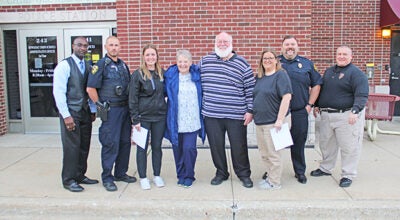Bush expanded health centers
Published 10:16 pm Thursday, February 17, 2011
Dr. Lori Checkley, Cassopolis Family Clinic
While President Barack Obama gets bashed for government takeover of health care and “Obamacare,” Dr. Lori Checkley reminded Dowagiac Rotary Club Thursday noon that it was President George W. Bush who presided over Community Health Centers’ “tremendous growth” of 67 percent since 2000.
“The number of actual centers has doubled” during that decade, Dr. Checkley said. “It actually goes back to President Bush. He was a very big proponent of health centers and increased funding and the number of centers grew quite rapidly.
“The reason both presidents have been proponents is they are cost-effective. Specifically, a lot of money is saved by keeping people who otherwise would not be able to access care out of the emergency room and out of hospitals. We’re able to provide preventive care. We’re not just taking care of problems once they get to the point where a person needs hospitalization.”
Federally-Qualified Health Centers (FQHC) are a type of clinic which uses federal and some state funds to provide health care to populations underserved because they are “medically indigent” or isolated rural or inner-city areas.
Born of President Lyndon Johnson’s 1960s War on Poverty, they are governed primarily by the Federal Bureau of Primary Care.
“The goal of FQHCs is to provide care to patients who otherwise wouldn’t be able to get that type of care, regardless of their insurance status or ability to pay,” she said at Elks Lodge 889. “No two clinics are alike in how they achieve those goals, even in certain communities that have more than one clinic.”
Dr. Checkley is affiliated with Cassopolis Family Clinic, which is not a “free clinic,” but charges patients on a sliding fee scale in line with their ability to pay. No one is turned away.
“Usually, it’s around $20 a visit. Free clinics do great work, but the down side is that there usually are one or two people who if they leave or aren’t able to do it anymore, it falls apart. There’s not a lot of continuity or permanent records. We’re a low-cost alternative” that serves 8,000 patients in Cass County and southeast Berrien County. In 2009, there were 31,000 visits and 500 babies delivered.
In the future, “We’ve applied for a New Access Point Grant. If that is approved, we’ll be taking over the Rural Health Clinic in Niles that has been run by Southwestern Medical Clinic in the past. They’ve had it for many years and done a wonderful job, but financially, it’s not something they can continue to do. That would double or triple the number of visits we have a year,” Dr. Checkley said.
“A Service Expansion Grant would provide an on-site pharmacy for our patients. We want to add additional providers, including a social worker of our own to help address mental health issues and to build a new building” to replace the “maze” of offices added on at 109 School St. in Cassopolis.
“We’ve applied for a grant to have school-based clinics” grades 6-12 with a nurse practitioner for well care since many school districts no longer employ nurses.
“Kids kind of disappear after they start school until they come back as adults. Blood pressure is a big issue, diabetes more common.”
“Eventually, we may even expand into St. Joseph County, Mich., which is underserved. Another big area we’re going to be working on as we expand into the Niles area is ER diversion because of the big cost to the government from people with primarily Medicaid coming to the ER with problems that could be handled in the office.”
Dr. Checkley, a Cassopolis native who earned her medical degree from Indiana University, said, “We have a lot of state-of-the-art equipment despite our humble beginning. We can do well care, sports physicals, immunizations, family planning services, chronic disease management and acute injury and illness. We take walk-ins and we’re open 8 to 8 Monday-Thursday and 8 to 5 on Friday. For folks who don’t have insurance, a lot of those things would be hundreds of dollars if they went to the emergency room. Unfortunately, we don’t have X-ray anymore. We had a very geriatric machine that finally died and no one could find parts for it. We hope to replace that in the future.
“We collaborate with the Health Department for dental services in Dowagiac. We set aside some federal grant money so they can get evaluated and treatment in the $400 range to get their dental situations taken care of. We have some insurance patients who come because they like the providers and the convenience.”
FQHCs are governed locally by a community board of directors. Its members meet monthly and must consist of at least 50 percent of clinic patients “to keep us responsive to the needs of the people we’re serving. In Cassopolis, in particular the last few years, mental health services have been a big issue.
“We have Woodlands (Behavioral Healthcare Network), which is a Community Mental Health Care Center, but unfortunately, because of funding cuts they’ve had to really cut back on what they can do. That leaves a lot of people who are not severely chronically mentally ill, but struggling with depression and other mental illnesses, and seeking an easy way to get treatment. That’s a specific issue for our area. Because we’re a relatively rural area, transportation is a big problem. Many of our patients don’t have reliable vehicles to come in from out in the townships.”
Checkley said nationally, Health Centers care for one in eight Medicaid patients — “our clinic gets a special reimbursement, making it more affordable to provide the care” — one in seven who lack insurance, one in three people who live in poverty and one in seven rural residents regardless of income.
“Rural areas are very difficult to get medical services to,” she said. “Medicine is a business. You have to have a certain amount of patients to be profitable, so independent doctors are unlikely to locate in rural areas because they can’t keep their practices open.
“Nationally, 70 percent of low-income people being seen in an FQHC are at or below poverty level, which in 2008 was $17,170 for a family of three. About 80 percent — and our numbers are very similar to national numbers — are under some kind of federal insurance program, predominantly Medicaid or Medicare.
“Racial and ethnic minorities are disproportionately served through FQHCs. In our particular center, our population we serves reflects the community, but it’s a little bit higher proportion of African Americans than the general population of Cass County, but we don’t have a high Hispanic population in our center. However, some of the FQHCs farther west where there are more migrant populations have very high Latino populations.”
“We try to be very proactive with disease management,” Dr. Checkley related. “Medical conditions like diabetes, congestive heart failure, chronic obstructive lung disease, we try to put in place protocols to manage those illnesses and decrease the exacerbations that get people hospitalized.”
One challenge Dr. Checkley sees is making community members aware of services available.
“In the last couple of years, as people who always had insurance lost their jobs, they had never needed any kind of help. It’s difficult to get to them and to let them know they don’t have to quit taking their medications. People who are new to joblessness and to poverty don’t have the savvy of the system. One of my goals is getting the word out.
“And, of course, federal and state budget cuts are an issue for us, too. Last year, dental was dropped from Medicaid for adults. We did still have our grant, so we were able to get people emergency help. Everybody wants a piece of the pie, and the pie’s smaller.
“At heart, I’m kind of a liberal-conservative cross, so I worry when the federal government throws out $11 billion. You don’t want FQHCs to pop up everywhere without quality control. That would hurt everyone in the long run if a lot of clinics open up that can’t be sustained. Kind of like some of the recovery projects.”






